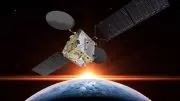The European Space Agency (ESA) has signed a contract with Thales Alenia Space in Italy to lead a European consortium of aerospace industries in building the Argonaut Lunar Descent Element, ESA’s first lunar lander.
ESA’s Argonaut represents Europe’s autonomous and versatile access to the Moon, supporting international exploration endeavours on the lunar surface. From the start of the next decade, the spacecraft will launch on regular missions to the Moon, and could be used to deliver infrastructures, scientific instruments, rovers, technology demonstrators as well as vital resources for astronauts on the lunar surface, such as food, water and air. Argonaut will be able to survive the harsh lunar night and days for five years, providing a key capability for sustainable lunar exploration.
Argonaut is a cornerstone of ESA’s lunar exploration strategy and is designed to work seamlessly with ESA’s Lunar Link on the Gateway and Moonlight communication and navigation systems. Argonaut is one of Europe’s contributions to international lunar programmes, particularly NASA’s Artemis programme and commercial lunar lander services, contributing to establishing a permanent and sustainable human presence on the Moon.
“The Argonaut contract signature is a pivotal moment for Europe’s lunar exploration ambitions” said Daniel Neuenschwander, ESA Director for Human and Robotic Exploration. “This first-of-its-kind European lunar lander demonstrates ESA’s dedication to advancing our industrial capabilities in deep space exploration. Argonaut will enable Europe to contribute meaningfully to international partnerships, while paving the way for a sustainable human presence on the Moon. Europe is on its journey to the Moon and has broken the ground towards European autonomy in Exploration.”
The core team for the development of the Lunar Descent Element, is comprised of Thales Alenia Space in Italy (the prime contractor), Thales Alenia Space in the United Kingdom, Thales Alenia Space in France and OHB.
The Argonaut Lunar Descent Element (LDE) will be delivered in 2030 to be used for its first operational mission, ArgoNET, expected to be launched in 2031. The industrial consortium in charge of using the first Lunar Descent Element for ArgoNET will be selected by the end of 2026, following a successful definition phase.









Be the first to comment on "ESA’s first lunar lander to be built by Thales Alenia Space-led consortium"